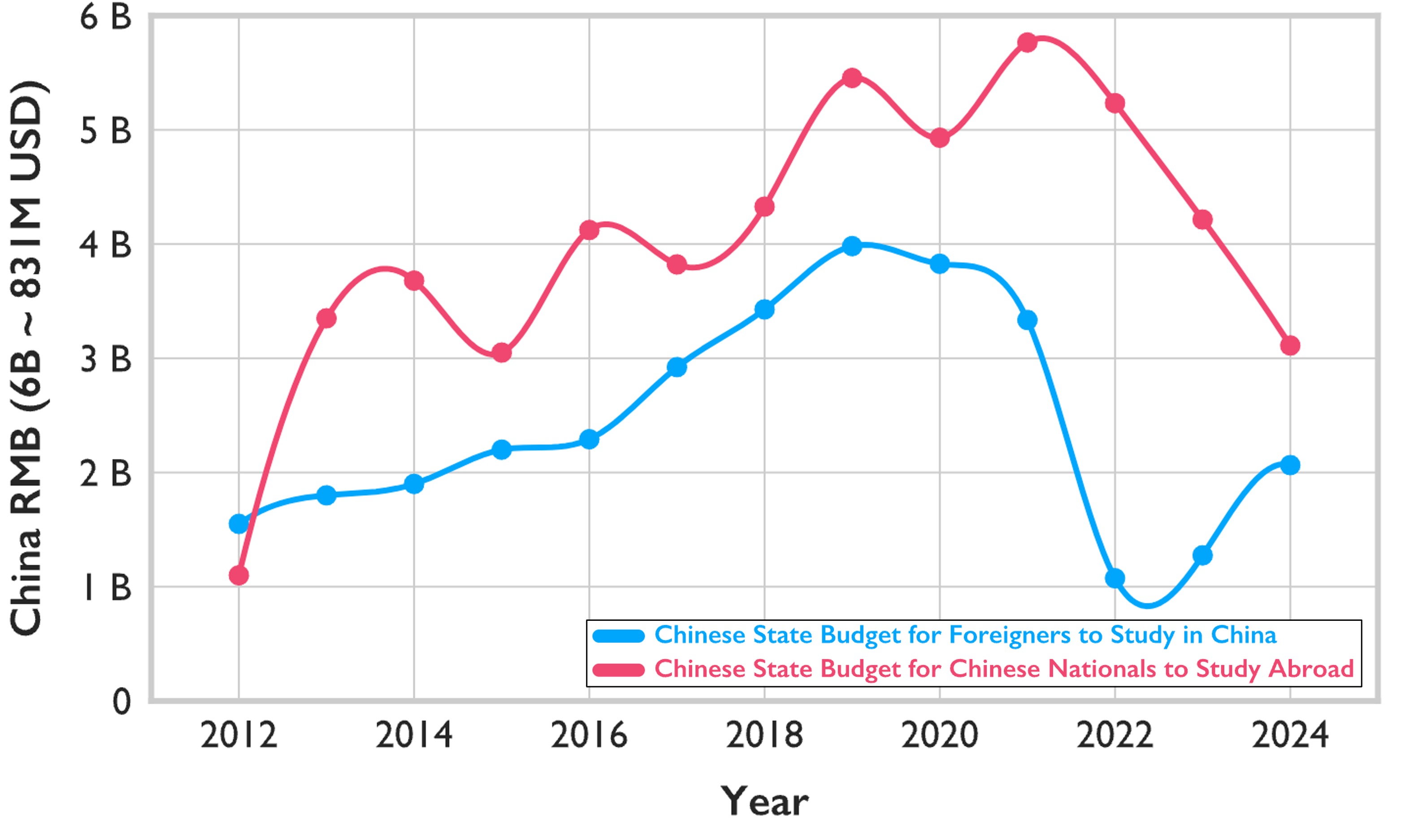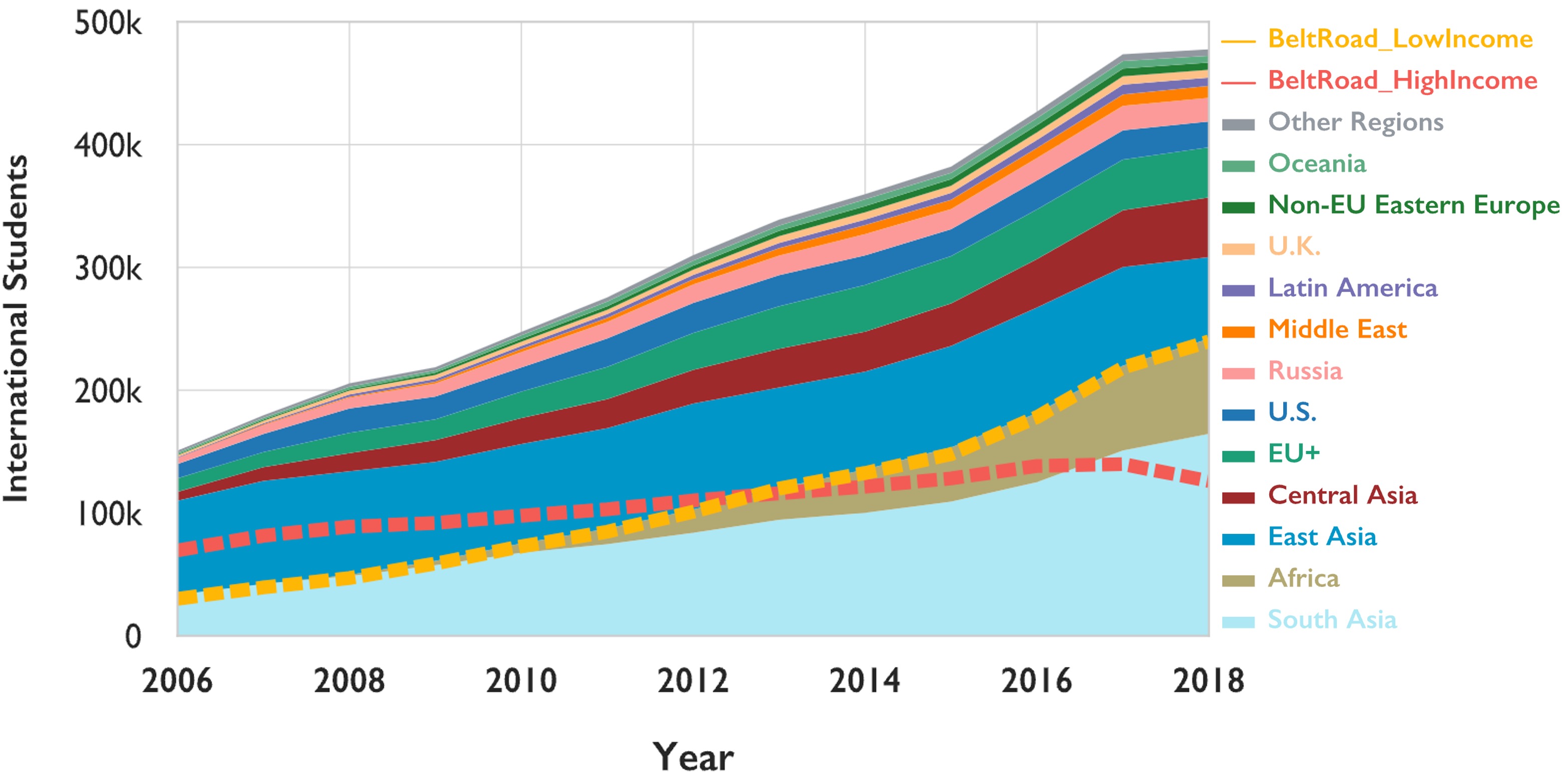Major shifts in the global system of science and technology are destabilizing the global status order and demonstrating the capacity for emerging countries like China and India to exert greater influence. In order to measure changes in the global scientific system, we develop a framework to assess the hierarchical position of countries in the international scientific collaboration network. Using a machine-learning model to identify the leaders of 5,966,623 scientific teams that collaborated across international borders, we show that Chinese scientists substantially narrowed their leadership deficit with scientists from the US, UK, and EU between 1990 and 2023 in absolute terms. Consequently, China and the US are on track to reach an equal number of team leaders engaged in bilateral collaborations between 2027 and 2028. Nevertheless, Chinese progress has been considerably slower in per-collaborator terms: after adjusting for the number of non-leaders from each country, our models do not predict parity between the US and China until after 2087. These dynamics extend to 11 critical technology areas central to ongoing diplomacy between the two nations, such AI, Semiconductors, and Advanced Communications, and to China’s scientific leadership with respect to the European Union and the United Kingdom. Thus, while China’s elite scientists are achieving leadership in the international scientific community, China’s scientific enterprise continues to face developmental constraints. We conclude by reviewing several steps that Chinese science is taking to overcome these constraints, by increasing its engagement in scientific training and research in signatory nations to the Belt and Road Initiative.
Keywords: science of science, scientific leadership, collaboration, geopolitics
1 Introduction
International research collaboration plays a pivotal role in scientific advance. Cooperation facilitates the sharing of specialized competencies, data, and resources, while promoting the global cross-pollination of ideas [1]. International knowledge flows have become driving factors for economic growth and competitiveness [2, 3], as science increasingly relies on large teams capable of performing heterogeneous tasks [4, 5, 6]. Despite these benefits, international collaboration in science is a delicate affair. Members of scientific teams contribute different resources, creativity, and knowledge, a role differentiation that imparts hierarchical structure to the international collaboration network. Nations with scientific and technological superiority are more likely to position their scientists in leadership roles, steering the direction of scientific research. In contrast, scholars from countries still developing their scientific capacity tend to conduct supportive roles, granting them less command over science’s direction and outputs. The imbalances that arise from the international division of scientific labor risk endangering global participation in international collaboration, and the enormous benefits it generates.
The United States has enjoyed nearly a century of leadership in global science, having obtained the position from Germany in the early 20th century [7]. The influx of research immigrants from all over the world greatly benefited the U.S.[8], sustaining its status and expanding its output. Concurrently, China has undergone a process of rapid development and research ascension. As the world’s second-largest economy, deeply integrated into the global trade system upon joining the WTO in 2001, China has also swiftly and successfully integrated into international networks of scientific collaboration over the past two decades, while continuously augmenting its investments in scientific research. China now outperforms the US in training more PhDs in the natural sciences and publishing more articles in top-ranked Nature-indexed journals [9].
These developments have occurred during an era of increasingly complex international relations and a rise in anti-globalization sentiment and policy. While recent crises, including COVID-19, underscored the need for international research collaboration [10, 11], the deteriorating political climate is eroding scientific ties and cooperation. Increasingly, scientists of Chinese descent in U.S. universities are experiencing increasing fear and anxiety, impacting their collaboration and career choices [7]. Furthermore, a recent report from the U.S. Department of State shows a significant decline in the number of international students from China in U.S. higher education institutions, from 373,000 in 2019-2020 to 289,000 in 2022-2023 [12].
While China’s economic growth has recently slowed, it continues to expand investment within its science and technology ecosystem. In addition, China is endeavoring to play an active role within international collaboration networks. Through increased investments in human capital, Chinese scientists are engaging more extensively with scientists in Central Asia, South Asia, and Sub-Saharan Africa, fostering the development of scientific enterprises in those regions. These investments could lay the groundwork for a ”Silk Road of Science,” extending China’s sphere of scientific influence, broadening its cooperative partnerships worldwide, and potentially providing an additional opportunity for its many scientists to exert leadership in international scientific collaboration.
In this paper, we report findings on China’s progress in achieving international scientific leadership, with respect to the US, UK, and the EU, and with respect to China’s international partners that are signatories to the Belt and Road Initiative. We used a machine learning model to predict the leaders of 5,966,623 scientific teams that collaborated across the borders of ”global regions” (such as China and the EU), and identified the share of team leaders involved in such collaborations that were based at Chinese institutions. By studying changes in China’s share of international team leaders across time, we generated forecasts for when China is expected to reach parity in terms of their propensity to lead in collaborations with scientists from the US, EU, UK, and signatory nations to the Belt and Road Initiative. In addition to our main analysis, we also examine administrative data from the Chinese Ministry of Education to uncover investments made by China in enhancing its scientific collaboration and talent cultivation in Belt and Road Initiative signatory countries.
2 China's Leadership in International Teams
(a)China-US Collaborators, 2010-2012
(b)China-US Collaborators, 2021-2023
(c)China’s Lead Share with Select Partners
 (d) China’s Lead Premium with Select Partners
(d) China’s Lead Premium with Select Partners
Figure 1:The Evolution of China’s Leadership in International Scientific Collaborations
To assess China’s leadership status in the international collaboration network, we adopted the machine learning model developed by [13], and data derived from publication contribution statements, to identify leaders within the nearly 6 million scientific publications indexed by OpenAlex that involved bilateral collaboration between 13 global regions, including China, the US, the UK, and the EU (Table S1). We find that Chinese scientific leadership vis-á-vis each of these three main partner regions increased substantially over our study period in absolute terms. Early in our study period (2010-2012), China had far fewer scientists with high lead probabilities involved in collaborations with the US than did the US with China (Figure 1(a)). Nevertheless, this relationship changed by the end of the study period (2021-2023), when China had more scientists at moderate lead probabilities than did the US, and has substantially caught up to the U.S. at the highest lead probabilities (Figure 1(b)).
To quantify changes in Chinese scientific leadership across time, we define scientists with lead probabilities greater than 0.65 as leaders, and all scientists with lead probabilities below this threshold as supporters. We use these measures to compute China’s Lead Share with the partner regions, given by the share of leaders involved in China-US, China-EU, and China-UK collaborations that worked at Chinese-based institutions in each year (Figure 1(c)). In 2010, about 30% of the leaders in China-US collaborations were in China and 70% were in the US. By 2023, 45% were in China and 55% were in the US. The relationship is approximated by a linear regression (????yitalic_y=0.012????xitalic_x-24.25), which is overlaid with 95% confidence intervals in Figure 1(c). The upper bound of the confidence interval predicts parity between the US and China in 2027, while the lower bound predicts parity in 2028. For China and the EU, our model predicts parity between 2025-2027. For China and the UK, our model indicates that China reached parity in 2019.
China’s rapid catch-up to the US, EU, and UK scientific leadership in absolute terms, as captured by the Lead Share, belies its potentially slower catch-up in per-collaborator terms. We computed China’s Lead Premium with each of the partner regions, which expresses a country’s leadership in per-collaborator terms. The Lead Premium is calculated as a country’s Lead Share minus its Supporter Share, and measures the extent to which China’s collaborators with each partner country are biased toward leadership roles as opposed to supportive ones. We find that China’s Lead Premium is not on track to reach parity with the US until after 2087, and that China is expected to reach parity with the EU between 2051 and 2108 and with the UK between 2032 and 2036 (Figure 1(d)). Therefore, China continues to face challenges in shifting its large number of supporter scientists into leadership positions in international collaboration teams.
3Journal Quality and Leadership Threshold
A view often expressed is that Chinese scientists may publish in lower-quality journals than do scientists from the US, EU, and UK. To test whether China’s growing international leadership may be restricted to low-quality journals, we subsetted our data by journals based on their 2021 Web of Science Impact Factor. Figure 2(a) shows predicted years of parity, with 95% confidence intervals, for China’s Lead Share and Lead Premium with the US across 5 impact factor journal bins. The point estimates for the Lead Share predict that China will reach parity with the US no later than 2034, irrespective of journal impact factor, while point estimates for Lead Premium predict that China will never reach parity with the US in high-impact journals. These results underscore that China’s most elite scientists are becoming international leaders in the top journals, but that substantial challenges remain in transitioning many of its supportive scientists to leadership roles.
 (a)Parity Year by Journal Impact Factor
(a)Parity Year by Journal Impact Factor

(b)Parity Year by Lead Probability Threshold
Figure 2:Year of Parity by Lead Journal Impact and Leadership Threshold
A second possibility regarding the emergence of Chinese scientific leadership is that China’s growth may be restricted to ”mid-level leaders”, while Western countries like the US might retain top-level leaders. To explore this possibility, we ran our model separately with different thresholds to define leaders. The point estimates predict that China will reach parity in Lead Share with the US at even the highest thresholds within the next two decades (Figure 2(b)). In terms of its Lead Premium, Chinese parity is further off, with parity never expected between the two countries at the highest thresholds.
4Chinese Leadership in Critical Technologies

Global interest in scientific leadership is linked to the centrality of science for economic production, the provision of IT infrastructure, and maintenance of security. In the United States, the National Science Foundation’s TIP Directorship defined 11 Critical Technology areas that it sees as essential to securing national objectives. These Critical Technology areas include Advanced Manufacturing, Advanced Materials, Artificial Intelligence, Biotechnology, Communications and Wireless, Cyberinfrastructure and Advanced Computing, Cybersecurity, Disaster Risk and Resilience, Energy Technology, Quantum Technology, and Semiconductors and Microelectronics. To assess the status of China-US leadership in these critical technologies, we ran our model separately for articles in each area (see methods).
Figure 3 shows China’s Lead Share and Lead Premium in bilateral scientific cooperation with the US over time in each of the 11 Critical Technology areas, plus a composite category. China is predicted to reach parity in its Lead Share with the US in the composite category between 2026-2029. Additionally, China is predicted to reach parity in its Lead Share with the US in 8 of the 11 Critical Technology Areas (AI, Disaster Prevention, Data Management and Security, Semiconductors, Advanced Communications, Energy, Materials Science, and High Performance Computing) before 2030. In Biotechnology, parity is not expected until 2030-2035, and in Quantum Information, parity is not expected until after 2029. In one field (Robotics and Advanced Manufacturing), our data is sparse, leading to noisy predictions. Finally, In terms of the Lead Premium, parity between the US and China is much further out, and not expected until after 2095 in the composite category.
In addition to the 11 Critical Technology Areas, we also analyzed our results by 6 broad scientific fields (Figure S12). We find that China is on track to reach parity in terms of its Lead Share with the US soonest in Chemistry and Materials Science (parity between 2023 and 2025), Mathematics, Physics, and Engineering (parity between 2023 and 2026), and Computer Science (parity between 2024 and 2026), and latest in Medicine (parity between 2031 and 2037). As in our other analyses, China’s parity in its Lead Premium with the US is forested to be substantially further out.
5China’s Silk Road of Science
Beyond the US, EU, and UK, we also found that China is engaging more deeply and broadly in scientific collaboration and talent development with the signatory countries of the Belt and Road Initiative. These developments would expand the scientific capacities of the signatory nations, while providing China with advantages associated with scientific leadership, including strengthening their mutual trust in science and technology and mobilizing more labor and resources toward their shared research objectives.
To study the growth of Chinese scientific leadership in Belt and Road countries, we first reviewed China’s Lead Share and Lead Premium with the Belt and Road signatory countries. A diverse set of countries have joined the initiative, including very wealthy countries such as Italy, Austria, and New Zealand, as well as developing countries. Therefore, we divided Belt and Road Initiative countries into two groups: those with GDP per capital below that of China using 2010 nominal values, and those with GDP per capital above China’s 2010 value. Figure 4(a) shows that China’s Lead Share is higher than that of the low-income Belt and Road countries, and that it crossed the parity line with high-income Belt and Road countries in 2020. Figure 4(b) shows that parity in China’s Lead Premium with both high and low-income Belt and Road countries looms in the near future. Therefore, the current trends in Chinese leadership with Belt and Road Initiative countries do not break from China’s leadership status with respect to the US, EU, and UK: while China has elite scientists leading international collaborations, it has many scientists not on track to assume leadership roles at the international scale, without unseen interventions.





One potential pathway through which China could shift more of its scientists into international leadership positions is by training young scientists from Belt and Road countries at Chinese universities. We examined budgetary data from China’s Ministry of Education, which reveal that the Chinese government budgeted over 32 billion RMB ($4.5 billion USD) between 2012 and 2024 to support foreign students’ study in China (Figure 4(b)). This amount is only 30% less than the amount China spent on its own nationals studying abroad, and is 66% of the size of the total budget requested by the U.S. National Science Foundation in 2018. Most importantly, while spending for foreigners’ study in China plummeted during the COVID-19 pandemic, it re-surged in 2023 and 2024, which suggests that China plans to continue these investments.
Student-level data from the Chinese Ministry of Education reveal the geographical origin of foreigners studying in China (Figure 4(c)). In 2006, most of China’s foreign students were from East Asia, with a smaller share from South Asia. The share from South Asia and Africa grew over time, and collectively accounted for nearly half of all of China’s foreign students by 2018, the most recent year for which the Ministry has provided data. Dotted lines in Figure 4(c) show the number of students from Belt and Road signatory countries that studied in China in each year, broken out by country income level. During the time series, China shifted from hosting more Belt and Road students from high-income countries, to hosting more Belt and Road students from low-income countries. Thus, China shifted its student inflows toward countries with which its own leadership may be more readily developed.
Finally, to identify the type of research produced by foreigners studying at Chinese universities, we conducted a content search through the full corpus of masters and doctoral theses in the China National Knowledge Infrastructure (CNKI) database. The CNKI database is one of the most comprehensive repositories of scholarly content published in China. We recorded the number of theses written by Chinese nationals and by foreigners studying in China that were related to the Belt and Road, as an indicator of the extent of research activity in China that is helping China to deepen its global integration. In 2012, 0.21% of the theses written in China were about the Belt and Road, but by 2019 that figure rose to 1.17%. More importantly, the number of theses about the Belt and Road written by foreigners studying in China rose six-fold during the same time period (Figure 4(d)). Thus, through a combination of its education subsidies and rising scientific prominence, China is attracting immigrant students to its country, where they are engaging in research that promotes cultural exchange and deepens cultural and economic integration between their home nations and China.
6Discussion
Our findings document the rapid growth of Chinese scientific leadership in the global collaboration network, as well as challenges China faces in shifting its population of scientists into international leadership. Analyzing the full corpus of bilateral collaborations between China, the US, and the EU, we find that China is on track to achieve a leadership position with Western countries in absolute terms within the next decade. These findings extend to leadership in high-impact journals, the most elite levels of leadership, and 8 of the 11 technological areas central to ongoing diplomatic discussions. Despite this progress, China’s leadership growth is markedly slower in per-collaborator terms.
When considering policy action, these developments demand careful reflection. China and the United States benefit enormously from one-another’s excellence in science: scientists from the two countries collaborate more frequently than any other country or global-region pair, with the exception of the US and EU (Figure S1), and collaborations between China and the US disproportionately benefit science as a whole [14]. Policies to isolate scientific research in either country would entail large costs to both countries, as well as the rest of the world that benefits from the outputs of their research. Additionally, both countries have already developed strong positions of scientific leadership with respect to one-another and other global regions. This limits the leverage either country has to impede progress of the other.
For policymakers in the United States, China’s investment in scientific enterprises across Belt and Road Initiative countries inspires a different course of action: the US can deepen its investments in global human capital development. By expanding its scientific engagement in the developing world, through education, training, and scientific collaboration, the US can train a global workforce in the skills demanded by the US economy, facilitate cultural exchange, and strengthen its position as central pole of the global professional class.
Chinese policymakers may take note of China’s increasing Lead Share with partner countries, which signifies that China’s policies to develop its scientific capabilities have helped make the country’s elite scientists globally competitive. Nevertheless, attention should also be directed at China’s slower growth in its Lead Premium, which suggests that additional action could be taken to bolster leadership and innovation capabilities across its population of scientists. In this regard, China’s recent investments in cultivating the scientific ecosystems in Belt and Road countries may prove a fruitful strategy, and could be expanded. Chinese policymakers may consider increasing investments to enhance the quality of talent cultivation. By leveraging the educational resources and scientific strengths of China’s institutions as well as those of more developed Belt and Road countries, they can improve the educational levels of international students and expand training programs for professionals critically needed by less developed Belt and Road countries.
Most importantly, our findings suggest that the dynamics of U.S.-Chinese competition in scientific leadership can be shifted in a more productive and mutually-beneficial direction. Whether or not competition results in negative or positive outcomes depends on the nature of the competition. Efforts to restrain the scientific progress of either country is hazardous, and such efforts are unlikely to succeed given the sophistication of both countries’ scientific enterprises. On the other hand, competition that takes the form of integrating each country’s science more deeply into global scientific networks through investments in human capital development would generate positive externalities for the world, by expanding global educational opportunities and accelerating scientific progress.
7Methods and Materials
Publication Data
We source publication data from the December 2023 data dump of OpenAlex, the largest repository of scientific publications in social, natural, physical, computational, and biological science journals. We sourced all published articles (5,966,627 publications) that fit the following criteria: (a) the publication date was after 1990, (b) the publication appeared in a journal with a 2021 impact factor of 1 or greater, and (c) the authors of the publication were affiliated with research/educational educations (universities, research institutes, or think tanks) located in two Global Regions, as defined below. This third criterion implies that we subsetted only the publications that involved bilateral collaborations between scientists in two separate Regions of Geopolitical Significance. For example, we do not analyze publications involving three scientists, one from the U.S., one from the EU, and one from China, because the collaboration is not bilateral. We plot the number of publications by each region pair in Figure S1.
Definitions of Global Regions
We aggregated countries to Global Regions, based on their strategic orientation, funding regimes, and levels of scientific development. We defined 13 Global Regions: China (excluding Hong Kong Special Administrative Region and Taiwan Province), the United States, the United Kingdom, the European Union (the EU27 plus Switzerland and Norway), Russia, Non-EU Eastern Europe, Oceania, East Asia, South Asia, Central Asia, the Middle East, Africa, and Latin America. A full list of countries by their assigned geopolitical region is provided in Table S1.
Identifying Team Leaders
To identify leaders in teams of scientists, we computed the lead probability for each author in each paper. Lead probabilities range from 0 to 1, with higher values indicating a higher likelihood that the given scientist was a cognitive and creative leader the the creation of the publication. Lead probabilities are computed separately for each author for each of her or his publications, using the method of [13]. Specifically, we utilized the dataset provided by [13], which parsed the 83,877 publications with self-reported author contribution statements from Science, Nature, PNAS, and PLOS ONE. These contributions were then clustered into lead-related contributions, indirect support-related contributions, and direct support-related contributions, as a function of the likelihood that each of these roles are held by the same person on the team (see [13]). Clustered leadership roles include the contribution statement activities: “conceive,” “design,” “lead,” “supervise,” “coordinate,” “interpret,” and “write.” Direct support roles include: “help,” “assist,” “prepare,” “develop,” “collect,” “generate,” “purify,” “carry,” “do,” “perform,” “conduct,” and “analyze.” Indirect support activities include “participate,” “provide,” “contribute,” “comment,” “discuss,” and “edit.” Using fractional assignment, authors were then assigned a lead value of 1 if they made lead-related contributions, and value of 0 if they made indirect support-related contributions or direct support-related contributions. Consequently, the resulting training dataset contains a list of all author-paper observations for the selected publications, each associated with their respective lead values according to the clustered contribution statements. We used 90% of the dataset from 4 as the training dataset and withheld 10% of the data for post-training model evaluation.
We trained the model using nine features: (1) number of references in the focal paper’s bibliography previously cited by the focal author, (2) number of topic keywords appearing in the focal paper that previously appeared in an author’s prior publications, and (3) number of self-citations in the focal paper to the author’s prior work, (4) career age of the author; (5) number of prior publications by the author; (6) total number of citations received by the author leading up to the focal paper; (7) number of unique keywords explored by the author leading up to the focal paper; (8) number of past publications where the author ranked as the first author or the last author; and (9) the affiliation score based on the importance rank of the author. Using the withheld 10% of the dataset, our model has a precision of 0.692 and a recall of 0.705.
Our model differs from the one used by [13] in that ours does not consider author order or corresponding status when predicting lead probabilities (which is unreliable for international publications), ours includes self-citations and affiliation rank. See Figure S4 for the distribution of lead probabilities for the 5,966,623-paper dataset. We exploit the bimodal distribution of the lead probability distribution to create a binary classification of leaders. In the main analyses, we defined all authortimes×paper observations with lead probabilities >> 0.65 as “leaders” and all observations with lead probabilities leq≤ 0.65 as “supporters”. In Figure 2(b), we showed results using multiple lead probability thresholds to create a binary leadership definition.
We computed the Lead Share on a pairwise basis, as the share of leaders that engaged in a bilateral collaborative team between two Global Regions that were from the focal Global Region. We computed the Lead Premium as each country’s Lead Share minus its Supporter Share. Finally, we note that these two measures are complementary, and reveal different attributes about a Region’s position in the global collaborative network. For example, China has a very large population of scientists, which naturally lends it to perform well in terms of its Lead Share (because only a small share of China’s scientists need to lead internationally for the country to have a high Lead Share with partner Regions), but also to perform poorly in terms of its Lead Premium (because it would be very difficult for the majority of China’s many scientists to establish leadership positions internationally). We thus report both measures, allowing for contextualized interpretation.
References
- [1]Richard B Freeman and Wei Huang.Collaboration: Strength in diversity.Nature, 513(7518):305–305, 2014.
- [2]César A Hidalgo, Bailey Klinger, A-L Barabási, and Ricardo Hausmann.The product space conditions the development of nations.Science, 317(5837):482–487, 2007.
- [3]Richard B Freeman.Immigration, international collaboration, and innovation: Science and technology policy in the global economy.Innovation Policy and the Economy, 15(1):153–175, 2015.
- [4]Stefan Wuchty, Benjamin F. Jones, and Brian Uzzi.The increasing dominance of teams in production of knowledge.Science, 316(5827):1036–1039, May 2007.
- [5]Benjamin F. Jones.The burden of knowledge and the ”death of the renaissance man”: Is innovation getting harder?Review of Economic Studies, 76(1), 2009.
- [6]Carolin Haussler and Henry Sauermann.Division of labor in collaborative knowledge production: The role of team size and interdisciplinarity.Research Policy, 6(49), 2023.
- [7]Yu Xie, Chunni Zhang, and Qing Lai.China’s Rise as a Major Contributor to Science and Technology.Proceedings of the National Academy of Science, 111(26):9437–9442, 2014.
- [8]Petra Moser, Alessandra Voena, and Fabian Waldinger.German jewish émigrés and us invention.American Economic Review, 104(10):3222–3255, 2014.
- [9]Simon Baker.Chian Overtakes United States on Contribution to Research in Nature Index.Nature, May 2023.
- [10]Y Lewis.Research collaborations bring big rewards: The world needs more.Nature, 594(7863):301–302, 2021.
- [11]Roger N Beachy and Karen C Seto.Us–china science collaboration to solve global grand challenges, 2023.
- [12]International student totals by place of origin, 2000/01-2022/23.Technical report, Institute of International Education, 2023.
- [13]Fengli Xu, Lingfei Wu, and James Evans.Flat Teams Drive Scientific Innovation.Proceedings of the National Academy of Science, 119(23), 2022.
- [14]Bedoor AlShebli, Shahan Ali Memon, James Evans, and Talal Rahwan.China and the U.S. Produce more Impactful AI Research when Collaborating Together.arXiv, 2023.







